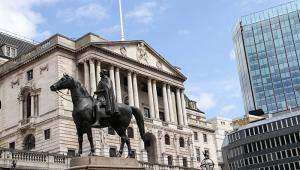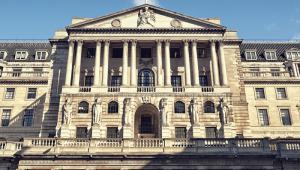The move by the Treasury to claim the surplus cash from the Bank of England’s quantitative easing programme is likely to cut public sector net borrowing in the short term, the Office for Budget Responsibility has said.
The government announced today that it had reached an agreement with the Bank to claim the excess cash held in the QE programme, known as the Asset Purchasing Facility. The Bank has bought £375bn of government debt since the programme began in 2009. As the government pays interest on all debt, the facility has built up a net surplus, which is expected to be around £35bn by the end of the financial year.
The Treasury said that allowing the surplus to build up in a state-owned institution was ‘economically inefficient’, as the government had to borrow to fund the payments.
Given that the scale and duration of quantitative easing had increased since the programme began, ‘it makes sense to normalise these cash management arrangements’, a statement from the Treasury said. From now on, this excess cash will be transferred to the Exchequer on a regular basis and used to pay down government debt.
This will improve transparency and mirror the practice of the United States Federal Reserve and the Bank of Japan, the statement added.
The transfer of cash to the Exchequer will be staggered across 2012/13 and 2013/14, with £11bn moved in the current financial year. From 2013/14, the ongoing cash surplus will also be transferred regularly on a quarterly basis.
As the money will be used to pay down debt, the change means Chancellor George Osborne will be more likely to meet his so-called ‘supplementary target’ on the public finances. This states that public sector net debt should be falling as a share of gross domestic product in 2015/16.
However, the OBR warned that ‘while this change will have a positive impact on the public finances in the short term, it will turn negative as and when monetary policy tightens’.
In a note released on the change, it said the decision to reflect the cash surpluses and deficits on an ongoing basis, rather than as a one‐off profit or loss when the facility closed, was ‘more transparent than the current approach’.
However, it added that it also made it likely that the government would have to make return payments to the APF in the future when, for example, the interest rate increases. The government had already agreed that it would meet any future losses in full.
‘The Office for National Statistics has yet to decide how to treat these flows, but we expect that public sector net borrowing will be lower in the near term than it otherwise would have been,’ it added. ‘Net borrowing is then likely to be higher in future years as the APF moves into deficit and the Treasury has to cover this. The APF's interest payments will increase when Bank Rate starts rising.’
Labour said the decision showed that Osborne ‘desperately needs to find a way out from his failing economic plan which has seen no growth and rising borrowing so far this year’.
Shadow chief secretary to the Treasury Rachel Reeves added: ‘This smoke and mirrors will fool nobody. We will look very closely at how the OBR and ONS account for this change and whether it ends up costing the taxpayer more in the long term. People will want to see public sector net borrowing figures without the impact of this change, so they can make proper comparisons and judgements.’





















